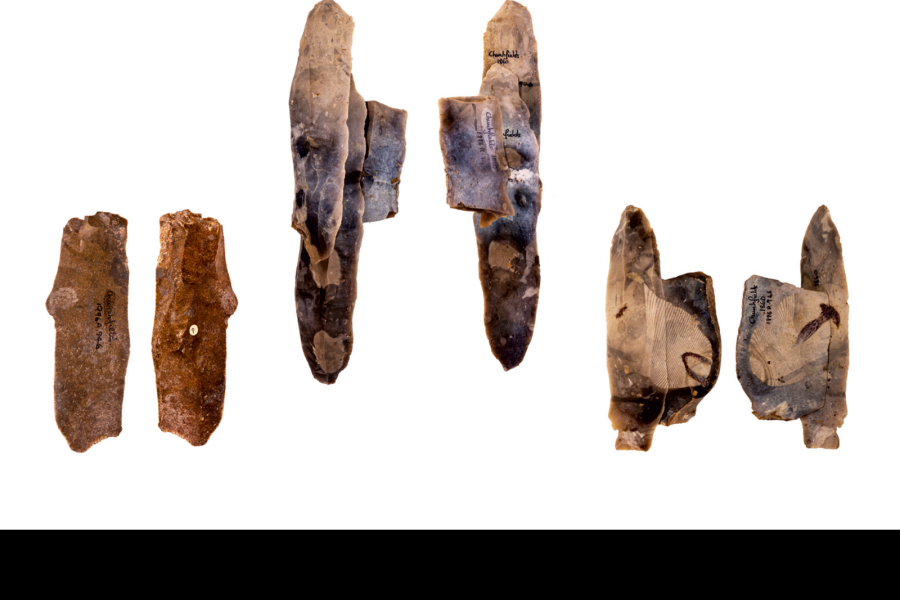The itinerary of sites that we have considered in this tour through Salisbury’s archaeological past, has been constructed on work undertaken by Wessex Archaeology. We digress from this trend to include a site that helps fill a gap in the story of human presence in the area, taking us back to the Palaeolithic (Old Stone Age - 900,000-10,000 years ago) period. The story features a collection of worked flints which demonstrate that important discoveries have not always been recognised when they were found. This was due to lack of knowledge at the time, allowing them to remain awaiting rediscovery in museum collections.
Thankfully we do have some detail about the flints; labels on some of them indicate that they were originally discovered in 1860, 160 years ago, at Churchfields, on the west side of Salisbury. At the time, the existence of the Palaeolithic had not been recognised, let alone its duration, indeed the discovery at Churchfields occurred only one year after Charles Darwin published his momentous volume ‘On the Origin of Species’. Some of the objects carry additional information stating that they were deposited at the museum by Dr Blackmore. This is almost certainly Dr. Humphrey Blackmore, a prominent Salisbury physician, who will feature again in our finale next week. Such educated people were often captivated by science, including the collection and study of antiquities. People of this status helped lay the foundations of archaeological research. They often made contacts with groups of workmen who would have noticed such ‘strange stones’ as they worked and passed or sold them on.

Extent of Churchfields and Victorian development as shown by Board of Health mapping (1860) and location of Wessex Archaeology's 2020 section (Map © Wiltshire & Swindon History Centre, reproduced with permission)
The precise place where the blades were found is uncertain, but old maps show that Churchfields extended from the River Nadder, through the present railway station to Wilton Road. These maps indicate that the north part of this area including the railway terminus had started to be developed by 1860, suggesting that the flints were found nearer to the river.

The location of Churchfields in Salisbury
Fortuitously, a small project for Wessex Archaeology in this area allowed us to examine the local geological deposits in more detail. The section, immediately north of St Clements Church, showed layers of red-brown clay, which had probably moved down from higher ground as a sticky mud during the glaciation, lying below the topsoil. The clay covered fine grained, buff coloured silt and grey-green sand which filled hollows in the surface of the terrace gravel. This fine-grained silt and sand may have provided well-draining conditions on which people would have chosen to live.

Section drawing and photograph of Wessex Archaeology's 2020 excavations, revealing geological deposits
The collection from Churchfields contains approximately 37 blades, which as we noted last week in our Mesolithic stop-over in Fisherton Street, are long, thin strips of flint that are ideal for conversion into other tools. Some of these blades are distinctive by their exceptional length, over 150mm long. Blades of this length, with characteristics of the manufacturing technique, are now recognised as being distinctive of the Upper Palaeolithic, between 40,000 and 10,000 years ago, at the end of the Palaeolithic period, when Britain was in the clutch of the last ice age. During the last 3,000 years of this epic event Britain underwent three warmer interludes when people were tempted back from further south, before being driven out once more by the return of ice. We can be reasonably certain that these flints were made at some point in this period.

Collection of principal objects from Churchfields, showing blade of Greensand chert (top left) and refitting flint blades (top right and bottom)
The collection had been catalogued, but largely forgotten. When it was re-examined, it was found that individual pieces could be fitted back together. This vital discovery showed that the flints may have been found near where they were made, establishing the location as an undisturbed Palaeolithic camp.
The location of Churchfields in the wider landscape
Such a discovery has immense importance; sites of this period are known from only two other locations in the Avon valley, at Hengistbury Head, Dorset and at a site, Nea Farm, near Ringwood, Hampshire, although another possible site has been noted at Petersfinger. In the River Test valley, a site of the same age has been found at La Sagesse, Romsey. The additional information we can learn from the rediscovery of the collection from Churchfields helps to illustrate the lifestyle of these early occupants of the area. We can appreciate that, just like the Mesolithic people, they lived and moved along the river valleys, possibly keeping to the slightly drier conditions provided by low terraces, which are found along the flanks of the floodplain. We can envisage that Churchfields provided an ideal stopping-off point, not only located where the River Avon joined the River Nadder but also within reach of the other rivers, allowing travel options in numerous directions.
We can also surmise that links may have been forged to the west, further along the Nadder valley. One of the blades (see above) was made from chert, a flint-like material that is most likely to have been obtained from the Greensand in the Vale of Wardour.
The rediscovery of this material is significant. It adds to the distribution of Upper Palaeolithic sites in the Avon valley, but also recognises advances in knowledge that accrue over time and the appreciation of stored collections in our museums.

